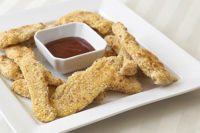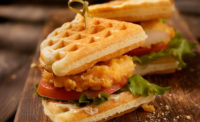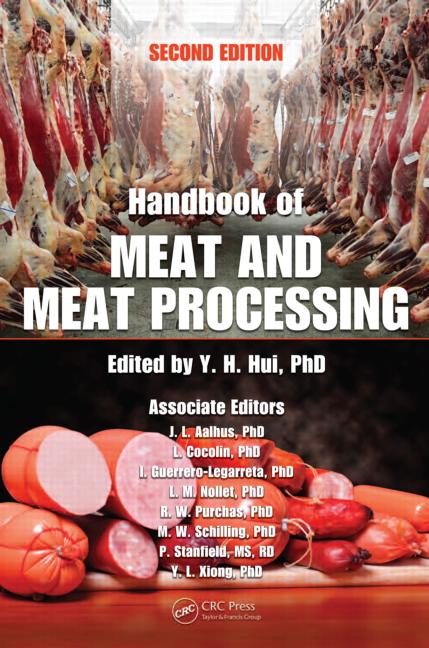Processing Tech | Ingredients
Batters & Breading: Attractive, yet polarizing
Consumers embrace chicken products with batters and breading, but other proteins suffer growing pains in the face of shoppers' health concerns.

Chicken is monopolizing the fried protein sector.
While concerns about health issues such as obesity, diabetes and heart attacks scare many consumers away from foods cooked in breading and batter, a large base of buyers still embrace fried chicken, which remains popular in foodservice and grocery settings.
Fried chicken appears on 52.6 percent of all restaurant menus, reports Datassential, a Chicago-based retail food and foodservice research firm, while breaded chicken is listed on 29.1 percent of menus, and battered chicken appears on 8.5 percent.
More restaurants elevate their breaded and battered dishes by incorporating hand-breading and hand-battering options, Datassential reports. Hand-breaded chicken is on 5 percent of menus, an 11 percent increase from a year ago and a 39 percent gain from 2013. Hand-battered appears on 1.7 percent of menus, a 28 percent gain from last year and a 21 percent increase from 2013.
In its review of the top 500 restaurant operators, Technomic Inc., a Chicago-based food industry research and consulting firm, found that 23 percent offer fried chicken, up from 20 percent in 2015.
In addition, 44 percent of the operators sell chicken strips and nuggets and 18 percent offer chicken or country fried steak, according to Technomic’s 2017 Center of the Plate: Poultry Consumer Trend Report.
“Battered and breaded chicken products have strong appeal across all major consumer groups,” from budget-conscious food shoppers who visit dollar stores to those who seek upscale products encrusted in organic flour and similar higher-end ingredients, says Tom Super, vice president of the Washington, D.C.-based National Chicken Council (NCC). “Much of the ongoing demand for this wide range of foods is being aided by the trend toward more snacking occasions and the shift to daily multi meals rather than traditional three sit-down square meals every day.”
While American’s increased desire to eat fried chicken at breakfast will likely help spur additional breaded and battered activity, an increasing shopper focus on health and wellness may limit the gains and even eventually cause demand for fried proteins to fall, says Maia Chang, Technomic senior research analyst, consumer insights.
A crush on chicken
Nevertheless, consumer enthusiasm for fried chicken is keeping demand for breaded and battered selections steady.
In listing their top five preparation methods for poultry, 43 percent of consumers include deep-fried or breaded for lunch and 42 percent list the selections for dinner, Technomic reports.
Consumers between the ages of 18 and 34 and those living in the South are most likely to prefer deep-fried or breaded poultry options, and that age group also is more likely to prefer chicken-fried and breaded preparations for beef, Technomic notes.
Because of a growing movement for the revival of classic dishes, traditional fried proteins are likely to become even more popular over the next few years, Chang says.
“Consumers crave new foods and experiences but seek the comfort that familiar options provide,” she says. “Look for more modern, unique twists on classic fare.”
Despite the already widespread popularity of fried chicken, marketers still are developing new recipes, says Maeve Webster, president of Menu Matters, an Arlington, Vt.-based food industry consulting firm.
“There is much innovation by merchandisers, some of whom are using flavors and preparation methods that originate from outside the U.S.,” she says. “Fried chicken in various forms is available almost worldwide and that is having a lot of influence over what is occurring domestically.”
Super notes creative product suppliers who offer tastier and lower-fat and lower-calorie options that can be more conveniently stored and prepared at home are poised to gain market share within all demographic groups.
“When these types of products find their way into home-delivery meal kits, there will be an additional bump up in sales volume,” he adds.
The heavy consumer interest in fried chicken, however, is making it difficult for other proteins, including pork and beef, to gain a strong foothold in the breaded and battered product sector, Webster says.
“Fried chicken is very traditional, widely accepted and familiar to consumers across the country,” she says. “Breaded and battered beef and pork are less common and there are more acceptance challenges because of the health and wellness issues.”
Many people view fried chicken as an indulgence and are unwilling to cut back on consumption, she says. Instead, they will forgo other health-adverse meals, a compromise many are unwilling to make for non-chicken proteins, she says.
Despite the uphill battle in getting consumers to embrace a wider range of breaded and battered proteins, merchandisers are working to create more attractive options. Measures include incorporating lighter batter that has soda or beer as ingredients and breading proteins with panko crumbs, Webster says.
Recipes also are including such healthier elements as whole-grain flours and ancient grains, she adds.
“The focus is on improving the perception of healthfulness, but getting more consumers to eat various proteins in the breaded and batter format is still a hard sell,” she says.
A host of hurdles
In addition to the lower demand for non-chicken options with breading and batter, many retailers are reluctant to develop such products because of the extreme time and effort it takes to prepare the selections, Webster says.
Because few processors are developing non-chicken proteins with breading and batter, merchandisers often must prepare selections from scratch, she says.
Such fresh options have a much shorter shelf life than frozen and refrigerated proteins and, because demand remains sketchy, the prospect of food waste from unsold items is higher, she says.
Food safety concerns also are likely to limit retailers’ motivation to produce non-chicken proteins with breading or batter, Webster says, noting “the more employees that handle fresh products, the greater the health risk.”
“There aren’t many value-added products that will reduce a retailer’s labor costs,” Webster says, adding breaded and battered chicken will remain attractive because of its strong demand and greater profit margins.
That popularity also likely will spur merchandising other battered or breaded chicken parts, including legs, wings and thighs, she says.
Datassential reports other product trends are expected to include the greater marketing of upscale fried chicken options, including ethnic and Southern recipes and items with higher-end ingredients.
Breadings also will become more varied as panko, tempura and pecan options take hold and merchandisers offer additional hand-breaded and hand-battered selections, Datassential reports.
“A lot of innovation with international influences, preparation techniques and flavors will occur across the board, regardless of the cut,” Webster says. “But barring a shift in the industry or actions by an influential chef, there won’t be anything pushing the non-chicken proteins to the forefront in breaded and battered formats.”
Pork gets a push
While merchandisers of non-chicken proteins in breading and batter face large hurdles in making the products more relevant, some report headway.
Consumer and retail operator interest in fried, breaded and battered pork is steadily increasing, with much of the activity occurring at independent restaurants, says Stephen Gerike, assistant vice president of channel marketing for the Des Moines-based National Pork Board (NPB).
Such a movement is likely the first step toward wider product growth, he says.
“Trends that emerge in independent restaurants will typically find a way into the mainstream food media and then to larger restaurant chains and supermarkets,” he says. “Grocery selections will first appear in the prepared foods section of deli departments before gravitating to the freezer and meat case.”
Datassential reports that breaded pork appears on 1.7 percent of restaurant menus, up 1 percent over the last year and 5 percent over four years. Of the selections, 22.8 percent are on American menus and 13.2 percent on Chinese menus.
Fifty-seven percent of the breaded pork selections are main entrees while 21.1 percent are sandwiches and 3.5 percent are rice entrees.
Battered pork, meanwhile, is on just 0.1 percent of menus, down 12 percent from 2016 but up from practically zero in 2013, Datassential reports. Of those selections, 30 percent are on Chinese menus and 20 percent on both non-Chinese Asian menus and American menus.
More popular is fried pork, which appears on 6.2 percent of restaurant menus, a 5 percent increase over the last year and a 3 percent increase over four years. Datassential reports 31.3 percent of the fried selections were breaded and that fried pork items are available at 7.9 percent of independent restaurant chains, 3.9 percent of regional chains and no national chains. Forty-four percent of fried pork menu options are entrees and 7.7 percent are hot sandwiches.
The growing Hispanic influence in U.S. food circles will lead to additional breaded and battered protein options, Gerike says. He notes selections that originate in different regions of Mexico will eventually be available throughout the U.S. Additionally, South American items such as Pan con Chicharron, a braised pork sandwich popular in Peru, will be more prominent.
Pork items in bread and batter, meanwhile, also appear more frequently in Japanese recipes, he says. Examples include breaded pork cutlets, breaded boneless pork chops and a growing demand for schnitzel.
Selections are expected to become increasingly popular as more Americans become acquainted with global and ethnic cuisines and chefs seek fresh menu alternatives with a foreign influence, Gerike says. Such items are likely to include Japanese foods “beyond sushi and ramen noodles,” he says, pointing to katsu sando, a fried pork cutlet sandwich, as an example.
Easy does it
Merchandisers that show grocery operators and consumers efficient ways to prepare breaded and battered protein selections also will help spur activity, he says, adding that technologies that enable grocers and foodservice operators to easily bread meat and poultry with panko are becoming ubiquitous.
Panko breadcrumbs have a lighter, flakier texture than traditional breadcrumbs and, in some instances, have been responsible for cutting a breaded protein product’s weight in half, Gerike says.
“There is an opportunity to educate retailers on how easy items are to prepare and that they can use ingredients that are already in the store,” Gerike says. “But merchandisers must make their consumers aware of the breaded and battered products or the shoppers won’t look for the items.”
Among the National Pork Board’s promotions for breaded and battered items is a breaded and fried pork shoulder on its consumer website, he says.
The growth potential for proteins with breading and batter, meanwhile, is favorable, Gerike says. Despite indications by many health-conscious consumers they will limit their intake of such foods, there still is a large segment of consumers who will remain active buyers.
“Millions of people a week buy meals at McDonald’s, so what people say and what they actually do are often two different things,” he says. “Many people are scared of everything, while others live on what is delicious, easy to make and what their family likes.” NP
Looking for a reprint of this article?
From high-res PDFs to custom plaques, order your copy today!










